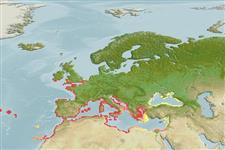>
Blenniiformes (Blennies) >
Blenniidae (Combtooth blennies) > Salariinae
Etymology: Coryphoblennius: Greek, koryphe = summit + Greek, belnnios = mucus (Ref. 45335).
Eponymy: Colonel George Montagu (1751–1815) was a soldier and natural history writer. [...] (Ref. 128868), visit book page.
More on author: Linnaeus.
Environment: milieu / climate zone / نطاق العمق / distribution range
البيئة
بحري القاع. Subtropical; 52°N - 20°N, 19°W - 42°E
Eastern Atlantic: along the coasts of western England and the British Channel, Spain, Portugal, France, Morocco, Madeira , Canary Islands; Mediterranean Sea, Sea of Marmara, and the Black Sea.
الحجم / وزن / العمر
النضج: Lm ? range ? - ? cm
Max length : 7.6 cm SL ذكر/ مختلط الجنس; (Ref. 5298)
Facultative air-breathing (Ref. 126274); Intertidal (Ref. 31184), found on the wave-battered rocky shores (Ref. 5298). May remain out of water under rocks and seaweeds (Ref. 31184). Omnivorous; feed mainly on copepods and ostracods as juveniles and shift to diet of algae as adults (Ref. 94105). Breathe air when out of water (Ref. 31184). Juveniles in small tide pools (Ref. 41018). Oviparous. Eggs are demersal and adhesive (Ref. 205), and are attached to the substrate via a filamentous, adhesive pad or pedestal (Ref. 94114). Larvae are planktonic, often found in shallow, coastal waters (Ref. 94114). Territories protected by males include depressions, crevices or piddock holes (Ref. 5981).
Life cycle and mating behavior
النضج | التكاثر | وضع البيض | بيض | الخصوبة | Larvae
Distinct pairing (Ref. 205). During mating, the male fans the nest as if cleaning and ventilating the area. Males release sperm during periodic quivers to fertilize eggs in the nest much like other blennies (Ref. 55747). Males guard the egg-masses of various females (Ref. 5981).
Bath, H., 1990. Blenniidae. p. 905-915. In J.C. Quero, J.C. Hureau, C. Karrer, A. Post and L. Saldanha (eds.) Check-list of the fishes of the eastern tropical Atlantic (CLOFETA). JNICT, Lisbon; SEI, Paris; and UNESCO, Paris. Vol. 2. (Ref. 5298)
IUCN Red List Status (Ref. 130435: Version 2025-1)
استخدامات بشرية
مصائد: غير ذات اهمية
أدوات
تقارير خاصة
Download XML
مصادر علي الأنترنت
Estimates based on models
Preferred temperature (مرجع
123201): 12.5 - 20.8, mean 18.6 °C (based on 504 cells).
Phylogenetic diversity index (مرجع
82804): PD
50 = 1.0000 [Uniqueness, from 0.5 = low to 2.0 = high].
Bayesian length-weight: a=0.00776 (0.00356 - 0.01695), b=3.00 (2.81 - 3.19), in cm total length, based on LWR estimates for this (Sub)family-body shape (Ref.
93245).
مستوى غذائي (مرجع
69278): 2.3 ±0.0 se; based on diet studies.
المرونه (مرجع
120179): عالي, الحد الزمني الأدني لتضاعف عدد أفراد المجتمع أقل من 15 شهر (Preliminary K or Fecundity.).
Fishing Vulnerability (Ref.
59153): Low vulnerability (10 of 100).
🛈
Nutrients (Ref.
124155): Calcium = 185 [37, 627] mg/100g; Iron = 1.71 [0.63, 5.45] mg/100g; Protein = 2.69 [0.00, 6.44] %; Omega3 = 0.285 [0.119, 0.650] g/100g; Selenium = 13.7 [2.6, 45.4] μg/100g; VitaminA = 23 [6, 85] μg/100g; Zinc = 1.61 [0.82, 3.32] mg/100g (wet weight);
